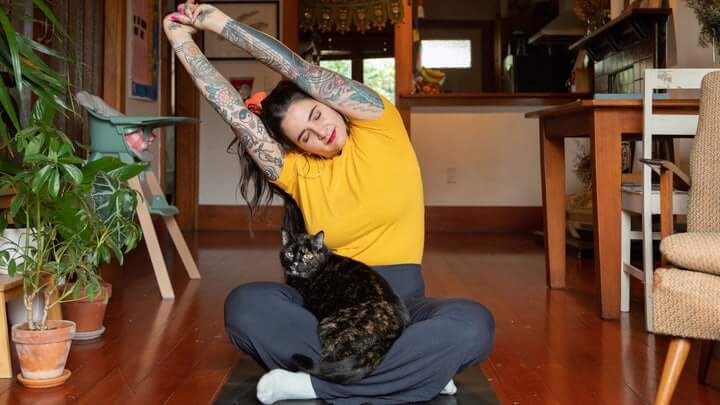AIF In The Media
- All Articles
- Consumer Press
- Elite Sports Partnerships
- Fitness Industry Podcast
- Network Magazine
- Trade Press

‘Healing Is Not Linear’: An Expert’s Guide to Returning to Exercise Post-COVID
At this point, it’s pretty safe to assume you or a few people you know have had a positive COVID-19 diagnosis. The Omicron variant has spread through Australia at an incredible rate, causing a whole lot of distress along the way. If you’re someone who has thankfully recovered from COVID (like me) you may be noticing that your energy levels aren’t back to 100 per cent, and your ability to exercise has been impacted.
If that’s the case, know that you’re totally not alone in that. This virus is a real jerk, and though some may characterise it as ‘mild’ that doesn’t mean it won’t still put your body through a tough time.
It should be made clear here that if at any point during or after a COVID diagnosis, you are concerned about your health, don’t hesitate to contact your GP. But if you’re generally feeling recovered and just want a guide to getting back on track with your fitness, you’ve come to the right place.
Kate Kraschnefski, Head of Compliance and Training at the Australian Institute of Fitness, has shared her tips on managing this tricky world of post-COVID exercise.
To start, what should we expect from post-COVID exercise?
Naturally, this will vary from person to person. Some people will return to full health really quickly with no residual fatigue. Others will have a slower recovery.
“COVID is a virus so even if your common COVID symptoms have passed, it is possible that you will feel fatigue or weakness for a period of time after,” Kraschnefski explained over email.
“This is normal and can happen after the body has fought off a viral infection.”
She shared that in many cases, people who have recovered from COVID will find they’re able to get back to their former training intensity after a few weeks. But there is no one-size-fits-all approach, here.
“Healing is not linear, and everyone’s recovery will be different based on unique factors to do with their health, fitness and environment,” she said.
The most important thing to remember is that you shouldn’t “be too disheartened if you have lost fitness”. Your body just fought off a virus, and it may take a little time for your strength to return. That is okay.
What are some good exercises to start off with?
When it comes to specific exercises to try after recovering from COVID, Kraschnefski stressed that it’s important to “start off slow”.
“…gentle cardio, mobility and stretching” are all great places to start from but be sure to “avoid any excessive strain and listen to your body”.
“Tune into your body and particularly take note of how the respiratory system is while doing your light cardio, like walking or cycling,” she said.
As a general rule, Kraschnefski suggested steering clear of high-intensity exercise during the weeks following your COVID recovery “as it’s likely your body will still be healing”.
Are there any key signs that indicate you should slow down?
On the topic of monitoring your body’s response to exercise after COVID, Kraschnefski said it’s important to keep an eye on your heart rate, breathing and general energy levels.
“If a light activity feels unusually difficult, best to opt for a gentler form of exercise,” she shared. The same goes if your body feels particularly fatigued after a workout.
“There are several stages of healing after a virus, so you want to make sure you are not taking away energy from what your body needs to do to get better.”
Overall, a little “light, restorative exercise” may feel good for your body in the early stages after COVID symptoms have subsided and you’re virus-free.
“After a week of that, try a little more intensity or duration with your cardio, 2-3 times per week,” Kraschnefski explained.
“If that feels welcome in the body, [in] week three you can bring in some light weights and slowly build your intensity and frequency back to what it was pre-illness from there.”
Combine this with lots of water, rest and nutritious food and you should have a recipe for a comfortable return to fitness after COVID. Just don’t push yourself too far and ask for help if you feel you need it.
If you’d like more guidance on physical activity post-COVID, the WHO has included some tips in its guide to managing the virus here.
























